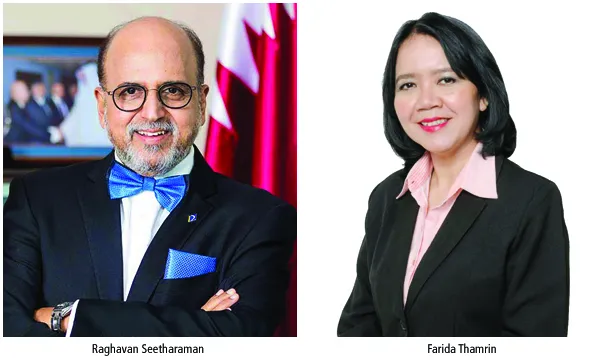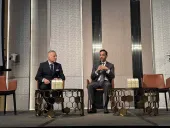
How real-time trading rocks the Asian forex boat
Bank Mandiri, Doha Bank, and UOB share their insights on how new platforms and technologies are changing the way they do forex.
When peer-to-peer international foreign currency and payments platform Midpoint collaborated with online accounting software company Xero, it was a boon for firms that needed to quickly pay their international suppliers in foreign currencies, but it was another blow to banks that until recent years were the preferred choice for settling international invoices.
Midpoint launched an add-on application that provides a “Pay Now” button included in the email request which facilitates the customer using Midpoint to pay a supplier requesting payment. A firm simply has to create a Midpoint account, authorise Midpoint to access Xero data, click “Pay Now” to pay the invoice, and the system finds a market match that often results in better foreign exchange (FX) rates and a fraction of the fees compared to traditional bank methods.
But aside from promising lower costs, these sleek new FX trading platforms are further enhancing their convenience and speed. The Midpoint-Xero collaboration, for example, enables an SME user to automatically notify suppliers that they have received payment and update accounts instantaneously after cross-border bills are settled. This promise of more seamless, mobile-accessible, low-cost FX transactions has helped the likes of Midpoint, TradeFintech and TransferWise grow in the past year and may be putting incumbent banks on the defensive, said Farida Thamrin, senior vice president of treasury group at Bank Mandiri.
“The fintech innovation in the past year has been able to eliminate those redundant processes and provide customers with real-time competitive price and faster settlement process,” she said, on what has driven the growth of new FX trading platforms, especially in the SME segment.
TransferWise has taken on an aggressive expansion strategy, including hiring hundreds of new staff, setting up new offices in key markets, and launching a major advertising campaign. “White labelling and real-time trading platform have transformed the FX market in terms of seamless transaction execution capabilities, processing, database management and compliance,” said Raghavan Seetharaman, CEO of Doha Bank.
White labelling has served to encourage new entrants by allowing them to acquire the use of technology and circumvent the cost of developing their own. But their success is hinged on finding a good partner and developing a strong sales channel to deliver their carefully selected list of FX products.
“The innovation will hurt conventional banks if they don’t embrace their financial technologies since the expansion of FX mobile trading platform is rapidly growing,” said Thamrin. “Therefore, banks should raise the bar in terms of price competitiveness using both online and mobile trading platform reliabilities using advanced technologies.”
Thamrin said the industry is also moving towards a battle of mobile apps, which are becoming more widely in use by customers that want to conduct their transactions anytime and anywhere. It is in these areas that incumbent banks must start to flex their relatively bigger financial muscles to thwart the advance of newer players.
Realising the importance of the mobile app in currency exchange, South Korean Shinhan Bank announced it will start accepting currency exchange orders in Japan through Line Pay, the mobile payment platform of the namesake messaging app, the most popular with an estimated 50 million Japanese users by the end of the year, according to an eMarketer forecast. Shinhan Bank made sure to make the mobile app service easy to use: A customer only needs to enter the currency and amount, and choose where and when to pick up the currency, with convenient locations such as the Narita and Haneda airports available. The currency can even be delivered at the customer’s doorstep.
Real-time FX info for SMEs
Singaporean bank UOB has introduced UOB Business, a mobile app that enables SMEs to manage their currency exposure and risk more effectively. Its notable features include live updates on FX rates and global market insights, and is available in Singapore, Malaysia and Thailand.
“The app was launched in response to the growing demand from SMEs seeking real-time FX information as their operations increasingly cross borders,” said Mervyn Koh, managing director and country head of business banking, Singapore at UOB. “Through the app, users can set alerts for when the price of a currency reaches a specified level. When the alert is triggered, they can connect with UOB’s FX specialists, who will then provide advice on FX solutions or help execute trades.”
Embattled blockchain
Blockchain has also been making waves in FX trading because what see as revolutionary potential to improve efficiency and speed in transactions, but Thamrin said it is currently facing an uphill battle in regulation. “The growth of the blockchain with its independency, transparency and vulnerability is surely appealing as an alternative solution in the current forex market system,” said Thamrin. “However, we don’t see that the blockchain becoming integral to the future of FX trading process yet.”
“This is due to the characteristic of the blockchain which is publicly available, but lack of control by certain regulator. If we put our perspective in the central government’s or central bank’s point of view, it will be almost impossible to trace the movement of fund, purpose of transaction, tax, and so on,” she said.
In some developing countries, blockchain technology is not regulated yet, prompting critics to raise concerns on transaction privacy and security. But in developed countries, big financial institutions are starting to test the waters. Seetharaman said blockchain technology is currently used mostly by global multinational corporations providing FX liquidity and database management, as well as major banks like JP Morgan.
Earlier this year, Goldman Sachs reportedly filed its first blockchain-related patent pertaining to a distributed ledger that can process faster, almost real-time FX trades. This is in contrast with traditional FX trades that can take up to days to complete, tying up critical capital and raising trading costs. But apart from handling the pressure of fintech rivals in real-time FX trading and keeping up with blockchain technology developments, Asian banks also need to worry about rising protectionism and regulatory compliance.
Growth drivers for FX
Thamrin noted that the US foreign policies under the Trump administration tend to protect the domestic market and labour, increasing the likelihood of increased barriers on China’s export to US and exit from critical trans-pacific partnerships. These bode grim tidings for Asian economies and, in turn, profitable FX activity in the region.
“The impact for the rest of the world will be in the form of limited global trade improvement,” she said. “Low export will bring low economic growth. In Asian countries, the impact will be more significant since they heavily rely on exports especially on commodity exports.”
She cited Indonesia, which had to deal with lower commodity prices driving lower economic growth in the past five years. Indonesia’s economy experienced a bit of a recovery this year, partly because of better commodity prices. Booming growth in Asian emerging markets had been a driving force of FX trading, and weakness could further decelerate trading volumes that have fallen recently.
Seetharaman, meanwhile, said US Dodd-Frank regulations could to be an effective damper on the Asian OTC market and “could potentially impact OTC swaps by providing stringent comprehensive framework for the regulation of the OTC swaps markets.”


















 Advertise
Advertise








